glacierbaze
Well-Known Member
- Joined
- Jul 6, 2012
- Messages
- 2,390
- Reaction score
- 611
- Points
- 113
- Age
- 75
- Model
- Seafarer
You should have a round deck plate over the sending unit. No need to pull up "floor boards".
Sending unit is probably on the top front of the tank, so you want to lower your trailer in front, rather than jack it up, and let the water settle there. I would want to know what, and how much is in there, before I started pumping anything.
Sending unit is probably on the top front of the tank, so you want to lower your trailer in front, rather than jack it up, and let the water settle there. I would want to know what, and how much is in there, before I started pumping anything.


